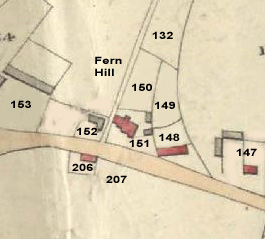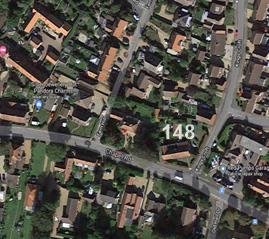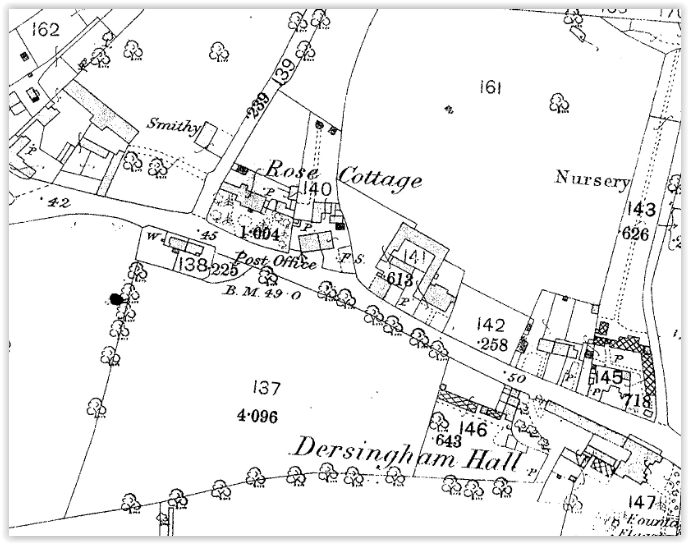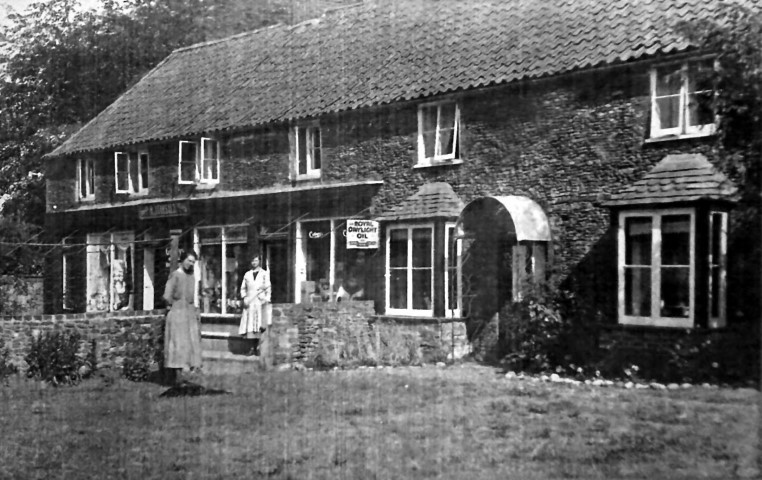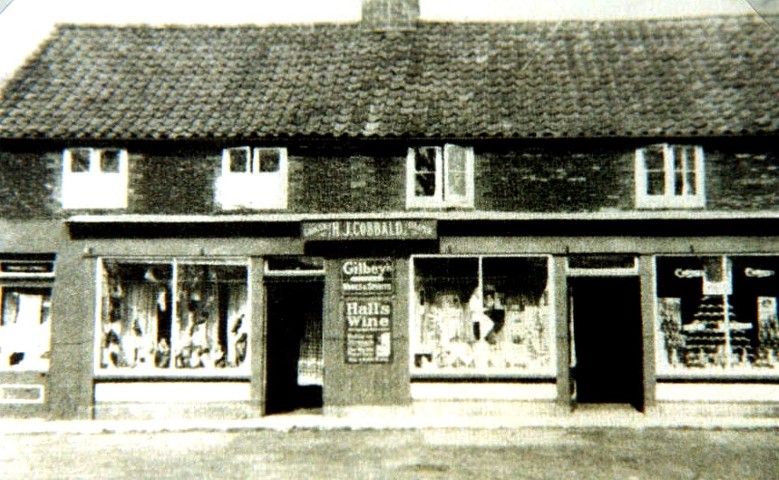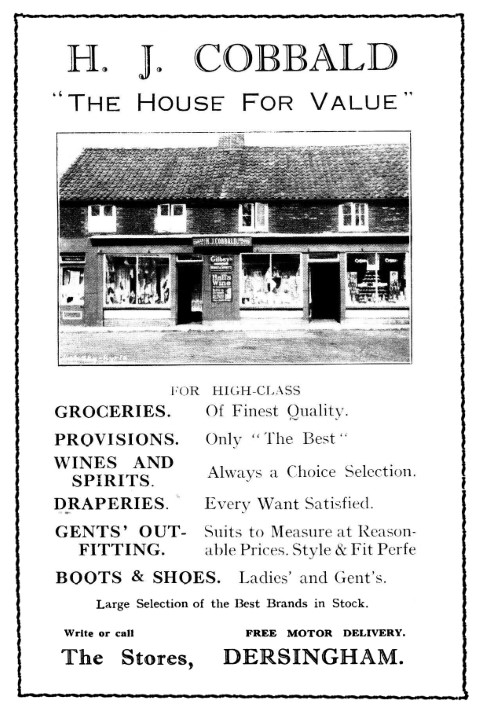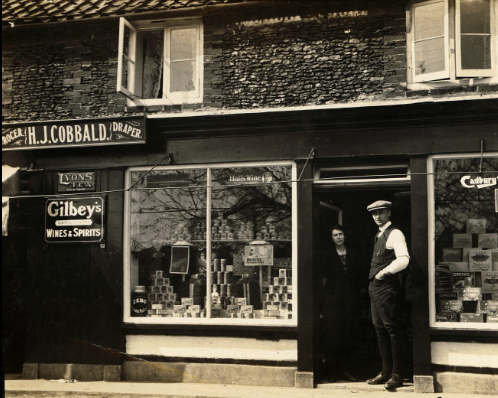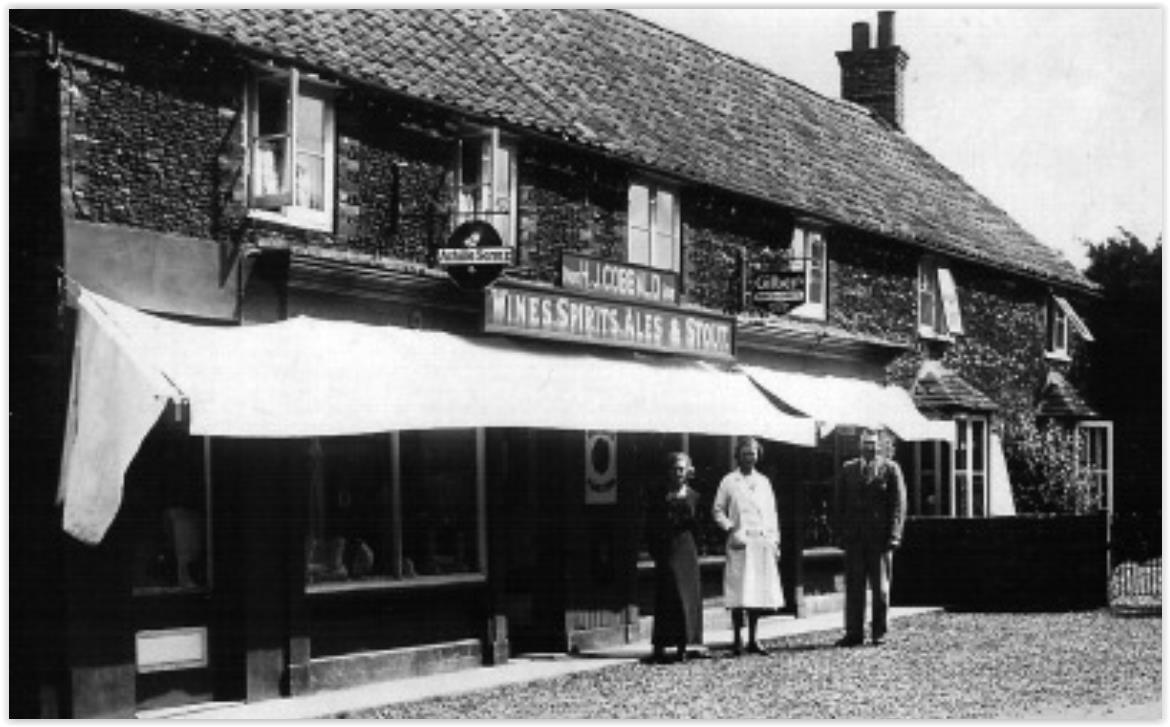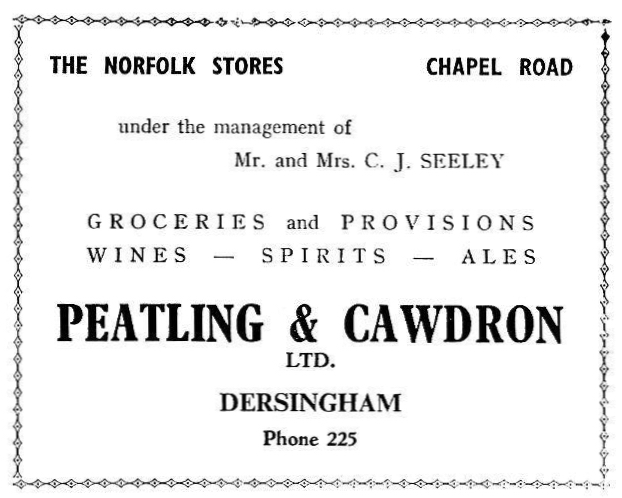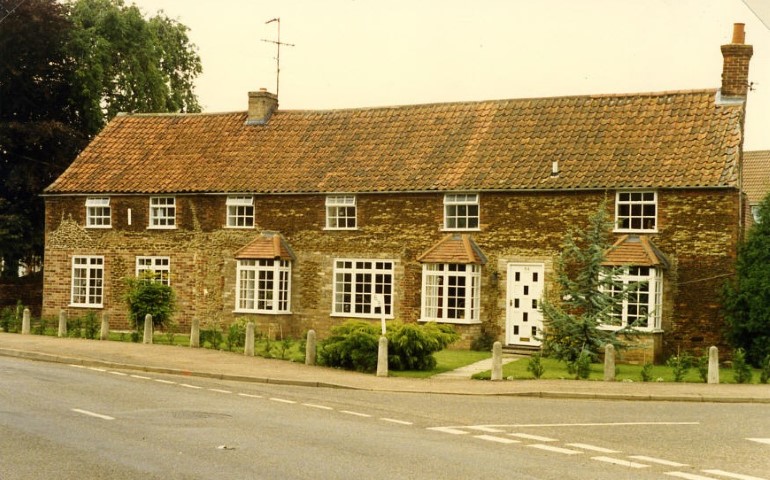The long cottage marked 148 is described in the 1839 Tithe Schedule as a House and Baking Office owned and occupied by William Thwaites who also owns and occupies 149, a garden and 132 , described as an arable Pightle A Pightle is the name given to any small enclosed piece of land.
To the left of the Baking Office, on the corner of Fern Hill is 151, Rose Cottage, buildings and garden and behind that 150, a garden, all owned and occupied by George Chadwick.
On the right hand side of the cottage, 147 are the house, buildings and yard occupied by John Platten but owned by the Trustees of Robert Elwes. In White’s Directory of 1845 it is interesting to find in the list of farmers, Robert Hunt to J. Platten. It would seem that although John Platten rented the land he employed someone else to run things. This would account for the fact that we have been unable to find a John Platten in the census of 1841 for Dersingham.
George Chadwick was a farmer who owned a substantial amount of land and property in Dersingham. As well as considerable holdings of arable, pasture, and marsh lands he owned Oak House Farm further down Chapel Road. The present Pottery is all that is now left of the large property that once stood there. It was known as The Oaks in the twentieth century but was largely destroyed by fire in 1965. George Chadwick also ran the Malting Office which was opposite the present day library and he leased that from Richard Stanton.
Robert Elwes 1819 – 1878 who owned the house and land 147 also owned the pasture land opposite,207 now the site of the Old Hall estate. He owned Home Pasture, and further tracts of arable land behind that all occupied by John Platten. In addition he owned further land in the village including the Dun Cow Inn and farm and the house, buildings and land of Dersingham Hall.
He was a Victorian traveller and painter and author of “A Sketcher’s Tour Round the World” which he published from his home in Congham in 1853. He was the second son of Henry Elwes of Colesbourne in Gloucestershire. His mother Susan Hamond of Westacre brought as her dowry into the marriage the estate of Congham.
Robert and his wife settled there in the 1850s and built Congham House which was largely destroyed by fire in 1939. They had ten children five boys and five girls.
Robert travelled extensively in his 20s and 30s. In 1848 he set out on a world tour that lasted over two years during which he recorded all he saw in his many paintings. It was on his return from that trip that he married. His prolonged absences abroad are probably why his property in Dersingham was administered by Trustees. With his wife, he embarked on a second world tour in 1865; he died in 1878. Perhaps it was at this point that at least some of his Dersingham property was acquired by the Sandringham Estate. Later records show that the property 147 was sold by King George VI in July 1938.
William Thwaites or Twaites
So in 1839 the cottage at 84 Chapel Road was owned and occupied by William Thwaites/Twaits a Baker and Flour Dealer. It seems possible that William would have obtained at least some of his flour from James Fitt who was the Miller of Dersingham Mill at this time.
In the 1841 census we find recorded William aged 49 and his wife Mary Ann, 56. Their son Samuel, aged 25, is working with his father as a Baker and completing the household is the daughter Hester.
By 1851 there have been significant changes. Samuel, now married to Lydia 36, born in Wormegay, is now the Baker and Grocer having expanded the business. He employs as assistant James Smith, 15 from West Newton and Maria Holmes, 19 from Gaywood, is the house servant. William, 58, meanwhile has retired and lives with his wife Mary Ann, 65 and eleven year old grandson Paul Twaites in separate premises but nearby.
Samuel is still recorded as a Baker in the village in White’s Directory of 1854.
William’s wife Mary Ann died on October 25th 1855 aged 66.
In the census of 1861 a William Twaites is recorded as a widower aged 69 and listed as a Cake Hawker. Such an occupation would be quite compatible with his previous occupation as a Baker. William is listed immediately after the entry for Rose Cottage then occupied by Christopher Coe a retired farmer. The next entry is for Enoch Beckett, Grocer and Draper followed by the entry for Emmanuel Boothby, a farmer of 95 acres employing 2 boys. This is the same pattern of buildings noted in 1839; Rose Cottage, the shop, and then the premises that are the Beck House of today. William was possibly living in one of the cottages on the opposite side of the road numbered 206 on the Tithe map. It is described in the schedule as “cottages with gardens”.
In 1861 Samuel Twaites had moved to West Newton with wife Lydia and a nephew Paul Twaits who is aged 20 and in occupation as Miller and Baker. However, he continues to be recorded in the Dersingham electoral rolls where his qualification to vote is given as “freehold houses and land near The Dun Cow.” Samuel continues to be a Miller and Master Baker and is still in West Newton in 1871.
By the 1881 census he had returned to Dersingham where he is described as a retired baker living with his wife Lydia and nephew Alfred Grice. They also have a lodger Thomas Tidy residing with them. By 1891 Samuel is living with Lydia in the first of the semi detached cottages on the right as you go up Sandringham Hill. In that census he is recorded as Retired Baker living on own means. At the same address are James Warren servant and Bessie, his wife. Samuel died on October 13th 1892 aged 77. His wife Lydia died in Brighton on February 8th 1904 aged 94 but she was buried in our churchyard with Samuel.
Enoch Beckett was born in 1831 in Kelsall, Cheshire. He came to Dersingham some time just before 1861 and took on the shop in Chapel Road from Samuel Twaits; it was then described as a Grocer and Drapery. He arrived with his wife Sarah and one year old daughter Eveline.(Evie). He employed Thomas Hooks as Apprentice, and Eliza Leader, 15, was a general house servant. Eliza Woodhouse was appointed Nursemaid to baby Evie. Tragedy struck the family in 1862 as in the church records for that year I found the burial of James William Beckett and his twin brother Charles Enoch. The boys had only been baptised a few weeks before. Happily, in 1865 another son Hayward was born to Enoch and Sarah.
The census of 1871 records Enoch as Grocer and Draper, with his wife Sarah, daughter Eveline, now 11, Son Hayward 6, and the newest addition to the family baby Alice just 8 months old. Joshua Johnson lives-in as Grocer’s Assistant with Arthur Beckett an apprentice. Susan Mindham from Snettisham is a General Servant.
The Directory of 1874 reveals a significant change as Enoch is now recorded as the Postmaster running a Post & Money & Telegraph Office and Savings bank from the premises. We are told that London and other letters are received through King’s Lynn by Mail Cart , arriving at 6.50 a.m. and dispatched at 6.25 p.m. Previously the Postmasters had been Isaac Bunn and then Mr. J.L. Adcock who was also a tailor. The location of their premises at that time is unknown at the moment.
In the 1881 census Enoch’s address is given as The Post Office. There have been further developments as the Postal business expanded. There are now wall boxes in the village at The Feathers and the station which are cleared at 5.45 each morning. Postal orders have been introduced and by 1883 the Parcel Post has been established. It would seem to me that the Postal business was gradually taking over more and more of Enoch’s time.
The Ordnance Survey map of 1884 (below) shows the Post office clearly marked in the Chapel Road Shop.


